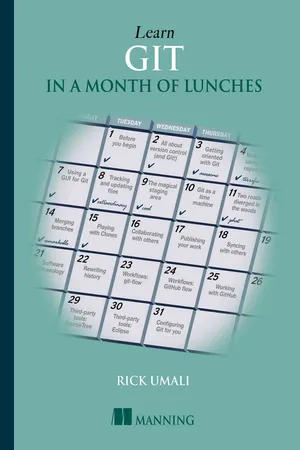
- 376 pages
- English
- ePUB (mobile friendly)
- Available on iOS & Android
Learn Git in a Month of Lunches
About this book
Summary Learn Git in a Month of Lunches introduces the discipline of source code control using Git. Whether you're a newbie or a busy pro moving your source control to Git, you'll appreciate how this book concentrates on the components of Git you'll use every day. In easy-to-follow lessons designed to take an hour or less, you'll dig into Git's distributed collaboration model, along with core concepts like committing, branching, and merging.Purchase of the print book includes a free eBook in PDF, Kindle, and ePub formats from Manning Publications. About the Book Git is the source code control system preferred by modern development teams. Its decentralized architecture and lightning-fast branching let you concentrate on your code instead of tedious version control tasks. At first, Git may seem like a sprawling beast. Fortunately, to get started you just need to master a few essential techniques. Read on! Learn Git in a Month of Lunches introduces the discipline of source code control using Git. Helpful for both newbies who have never used source control and busy pros, this book concentrates on the components of Git you'll use every day. In easy-to-follow lessons that take an hour or less, you'll dig into Git's distributed collaboration model, along with core concepts like committing, branching, and merging. This book is a road map to the commands and processes you need to be instantly productive. What's Inside
- Start from square one—no experience required
- The most frequently used Git commands
- Mental models that show how Git works
- Learn when and how to branch code
-
About the Reader No previous experience with Git or other source control systems is required. About the Author Rick Umali uses Git daily as a developer and is a skilled consultant, trainer, and speaker. Table of Contents
- Before you begin
- An overview of Git and version control
- Getting oriented with Git
- Making and using a Git repository
- Using Git with a GUI
- Tracking and updating files in Git
- Committing parts of changes
- The time machine that is Git
- Taking a fork in the road
- Merging branches
- Cloning
- Collaborating with remotes
- Pushing your changes
- Keeping in sync
- Software archaeology
- Understanding git rebase
- Workflows and branching conventions
- Working with GitHub
- Third-party tools and Git
- Sharpening your Git
Frequently asked questions
- Essential is ideal for learners and professionals who enjoy exploring a wide range of subjects. Access the Essential Library with 800,000+ trusted titles and best-sellers across business, personal growth, and the humanities. Includes unlimited reading time and Standard Read Aloud voice.
- Complete: Perfect for advanced learners and researchers needing full, unrestricted access. Unlock 1.4M+ books across hundreds of subjects, including academic and specialized titles. The Complete Plan also includes advanced features like Premium Read Aloud and Research Assistant.
Please note we cannot support devices running on iOS 13 and Android 7 or earlier. Learn more about using the app.
Information
Table of contents
- Copyright
- Brief Table of Contents
- Table of Contents
- Preface
- About this Book
- Acknowledgments
- Chapter 1. Before you begin
- Chapter 2. An overview of Git and version control
- Chapter 3. Getting oriented with Git
- Chapter 4. Making and using a Git repository
- Chapter 5. Using Git with a GUI
- Chapter 6. Tracking and updating files in Git
- Chapter 7. Committing parts of changes
- Chapter 8. The time machine that is Git
- Chapter 9. Taking a fork in the road
- Chapter 10. Merging branches
- Chapter 11. Cloning
- Chapter 12. Collaborating with remotes
- Chapter 13. Pushing your changes
- Chapter 14. Keeping in sync
- Chapter 15. Software archaeology
- Chapter 16. Understanding git rebase
- Chapter 17. Workflows and branching conventions
- Chapter 18. Working with GitHub
- Chapter 19. Third-party tools and Git
- Chapter 20. Sharpening your Git
- Index
- List of Figures
- List of Tables
- List of Examples